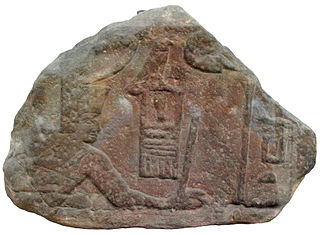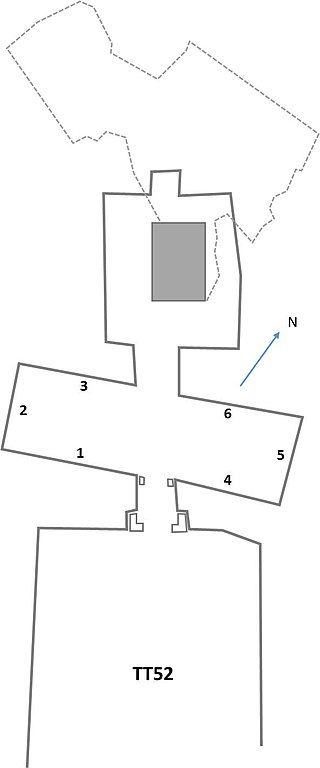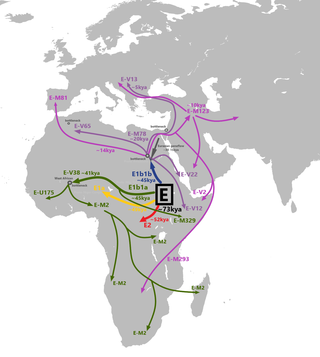Thebes or Thebae may refer to one of the following places:

Aten also Aton, Atonu, or Itn was the focus of Atenism, the religious system formally established in ancient Egypt by the late Eighteenth Dynasty pharaoh Akhenaten. Exact dating for the 18th dynasty is contested, though a general date range places the dynasty in the years 1550 to 1292 B.C.E. The worship of Aten and the coinciding rule of Akhenaten are major identifying characteristics of a period within the 18th dynasty referred to as the Amarna Period.

Thebes, known to the ancient Egyptians as Waset, was an ancient Egyptian city located along the Nile about 800 kilometers (500 mi) south of the Mediterranean. Its ruins lie within the modern Egyptian city of Luxor. Thebes was the main city of the fourth Upper Egyptian nome and was the capital of Egypt for long periods during the Middle Kingdom and New Kingdom eras. It was close to Nubia and the Eastern Desert, with its valuable mineral resources and trade routes. It was a religious center and the most venerated city during many periods of ancient Egyptian history. The site of Thebes includes areas on both the eastern bank of the Nile, where the temples of Karnak and Luxor stand and where the city was situated; and the western bank, where a necropolis of large private and royal cemeteries and funerary complexes can be found. In 1979, the ruins of ancient Thebes were classified by UNESCO as a World Heritage Site.

Sanakht is the Horus name of an ancient Egyptian king (pharaoh) of the Third Dynasty during the Old Kingdom. His chronological position is highly uncertain, and it is also unclear under which Hellenized name the ancient historian Manetho could have listed him. Many Egyptologists connect Sanakht with the Ramesside cartouche name Nebka. However, this remains disputed because no further royal title of that king has ever been found; either in contemporary source or later ones. There are two relief fragments depicting Sanakht originally from the Wadi Maghareh on the Sinai Peninsula.

Beni Hasan is an ancient Egyptian cemetery. It is located approximately 20 kilometers (12 mi) to the south of modern-day Minya in the region known as Middle Egypt, the area between Asyut and Memphis.

The necropolis of Draʻ Abu el-Naga' is located on the West Bank of the Nile at Thebes, Egypt, just by the entrance of the dry bay that leads up to Deir el-Bahari and north of the necropolis of el-Assasif. The necropolis is located near the Valley of the Kings.
Amenemḥat or Amenemhēt, hellenized as Ammenémēs or as Ammanémēs, is an Ancient Egyptian name meaning "Amun is in front". Amenemhat was the name of a number of kings, princes and administration officials throughout ancient Egyptian history.

Nakht was an ancient Egyptian official who held the position of a scribe and astronomer of Amun, probably during the reign of Thutmose IV of the Eighteenth Dynasty. He was buried in the Theban Necropolis in tomb TT52.

The Theban Tomb TT52 is located in Sheikh Abd el-Qurna, part of the Theban Necropolis, on the west bank of the Nile, opposite to Luxor. It is the burial place of Nakht, an ancient Egyptian official who held the position of a scribe and astronomer of Amun, probably during the reign of Thutmose IV during the Eighteenth Dynasty, the first dynasty of the New Kingdom.

The Tomb of Two Brothers is an ancient sepulchre in Deir Rifeh, Egypt. It contains the chamber tomb of the ancient Egyptian high status priests Nakht-Ankh and Khnum-Nakht, which dates from the 12th Dynasty. The whole tomb group is now in the Manchester Museum.
Khenemetneferhedjet(ẖnm.t nfr-ḥḏ.t) was an ancient Egyptian queenly title during the Middle Kingdom. It was in use from the 12th to the early 18th Dynasty. During the 12th Dynasty it also occurred as a personal name. Its meaning is "united with the white crown". The White Crown was one part of the Double Crown of Egypt and is usually interpreted to have represented Upper Egypt, but it is also possible that while the Red Crown represented the king's earthly incarnation, the White Crown represented the eternal, godlike aspect of kingship.

The ancient Egyptian Sail hieroglyph is Gardiner sign listed no. P5 for the sail of a ship. The hieroglyph shows a hoisted sail, curved because of wind filling it. It is used in Egyptian hieroglyphs as a determinative for words related to wind, air, breath, sailors,, floods-(of the Nile), etc. Also an ideogram in 'puff', 'wind', Egyptian ṯꜣw.
Nakhtpaaten or Nakht was an ancient Egyptian vizier during the reign of Pharaoh Akhenaten of the 18th Dynasty.
The Papyrus Lansing is an ancient Egyptian document written during the reign of the pharaoh Senusret III. The scroll was written in the 18th century B.C. by Nebmare-nakht, the royal scribe and chief overseer of the cattle of Amun. It was directed to his pupil, Wenemdiamun, and advocated the benefits of becoming a scribe while simultaneously denouncing other jobs such as farming and soldiering for the physical labor and danger involved. The text was later used as practice for new scribes.
The Memphite Necropolis is a series of ancient Egyptian funerary complexes occupying a 30-kilometer (19 mi) stretch on the Western Desert plateau in the vicinity of the ancient capital of Memphis, Lower Egypt, today in Giza, Egypt. It includes the pyramid complexes of Giza, Abusir, Saqqara and Dahshur, and is listed as the UNESCO World Heritage Site of Memphis and its Necropolis. Most of the pyramids of the Old Kingdom were built here, along with many mastabas and other tombs.

The genetic history of Egypt reflects its geographical location at the crossroads of several major biocultural areas: North Africa, the Sahara, the Middle East, the Mediterranean and sub-Saharan Africa.

Khnumhotep I was an ancient Egyptian Great Chief of the Oryx nome during the reign of Pharaoh Amenemhat I of the 12th Dynasty, Middle Kingdom.
Hetepi was an ancient Egyptian official of the Third Dynasty under king Djoser. Hetepi is mainly known from his monumental tomb found at Abusir-South. It belongs to the few well excavated and decorated Egyptian tombs of the Third Dynasty. The tomb was discovered in the winter season 1999–2000 by a Czech expedition. Alone the huge size of the tomb underlines the importance of Hetepi.










